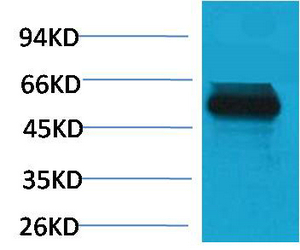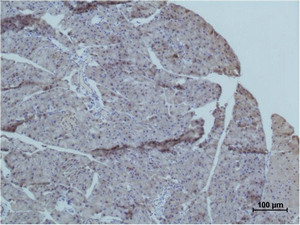TRIM72 Polyclonal Antibody
- 产品详情
- 实验流程
- 背景知识
Application
| WB, IHC-P |
|---|---|
| Primary Accession | Q6ZMU5 |
| Reactivity | Human, Mouse, Rat |
| Host | Rabbit |
| Clonality | Polyclonal |
| Calculated MW | 52731 Da |
| Gene ID | 493829 |
|---|---|
| Other Names | Tripartite motif-containing protein 72; Mitsugumin-53; Mg53 |
| Dilution | WB~~WB: 1:1000 IHC: 1:200-500 IHC-P~~WB: 1:1000 IHC: 1:200-500 |
| Format | PBS, pH 7.4, containing 0.09% (W/V) sodium azide as Preservative and 50% Glycerol. |
| Storage Conditions | -20℃ |
| Name | TRIM72 (HGNC:32671) |
|---|---|
| Synonyms | MG53 |
| Function | Muscle-specific E3 ubiquitin-protein ligase that plays a central role in cell membrane repair by nucleating the assembly of the repair machinery at injury sites (PubMed:36944613). Its ubiquitination activity is mediated by E2 ubiquitin-conjugating enzymes UBE2D1, UBE2D2 and UBE2D3 (By similarity). Acts as a sensor of oxidation: upon membrane damage, entry of extracellular oxidative environment results in disulfide bond formation and homooligomerization at the injury site (By similarity). This oligomerization acts as a nucleation site for recruitment of TRIM72-containing vesicles to the injury site, leading to membrane patch formation (By similarity). Probably acts upstream of the Ca(2+)-dependent membrane resealing process (By similarity). Required for transport of DYSF to sites of cell injury during repair patch formation (By similarity). Regulates membrane budding and exocytosis (By similarity). May be involved in the regulation of the mobility of KCNB1-containing endocytic vesicles (By similarity). |
| Cellular Location | Cell membrane, sarcolemma. Cytoplasmic vesicle membrane Note=Tethered to plasma membrane and cytoplasmic vesicles via its interaction with phosphatidylserine. {ECO:0000250, ECO:0000269|PubMed:36944613, ECO:0000269|PubMed:37770719} |
For Research Use Only. Not For Use In Diagnostic Procedures.
Provided below are standard protocols that you may find useful for product applications.
BACKGROUND
Muscle-specific protein that plays a central role in cell membrane repair by nucleating the assembly of the repair machinery at injury sites. Specifically binds phosphatidylserine. Acts as a sensor of oxidation: upon membrane damage, entry of extracellular oxidative environment results in disulfide bond formation and homooligomerization at the injury site. This oligomerization acts as a nucleation site for recruitment of TRIM72-containing vesicles to the injury site, leading to membrane patch formation. Probably acts upstream of the Ca(2+)-dependent membrane resealing process. Required for transport of DYSF to sites of cell injury during repair patch formation. Regulates membrane budding and exocytosis. May be involved in the regulation of the mobility of KCNB1-containing endocytic vesicles (By similarity).
终于等到您。ABCEPTA(百远生物)抗体产品。
点击下方“我要评价 ”按钮提交您的反馈信息,您的反馈和评价是我们最宝贵的财富之一,
我们将在1-3个工作日内处理您的反馈信息。
如有疑问,联系:0512-88856768 tech-china@abcepta.com.























 癌症的基本特征包括细胞增殖、血管生成、迁移、凋亡逃避机制和细胞永生等。找到癌症发生过程中这些通路的关键标记物和对应的抗体用于检测至关重要。
癌症的基本特征包括细胞增殖、血管生成、迁移、凋亡逃避机制和细胞永生等。找到癌症发生过程中这些通路的关键标记物和对应的抗体用于检测至关重要。 为您推荐一个泛素化位点预测神器——泛素化分析工具,可以为您的蛋白的泛素化位点作出预测和评分。
为您推荐一个泛素化位点预测神器——泛素化分析工具,可以为您的蛋白的泛素化位点作出预测和评分。 细胞自噬受体图形绘图工具为你的蛋白的细胞受体结合位点作出预测和评分,识别结合到自噬通路中的蛋白是非常重要的,便于让我们理解自噬在正常生理、病理过程中的作用,如发育、细胞分化、神经退化性疾病、压力条件下、感染和癌症。
细胞自噬受体图形绘图工具为你的蛋白的细胞受体结合位点作出预测和评分,识别结合到自噬通路中的蛋白是非常重要的,便于让我们理解自噬在正常生理、病理过程中的作用,如发育、细胞分化、神经退化性疾病、压力条件下、感染和癌症。







